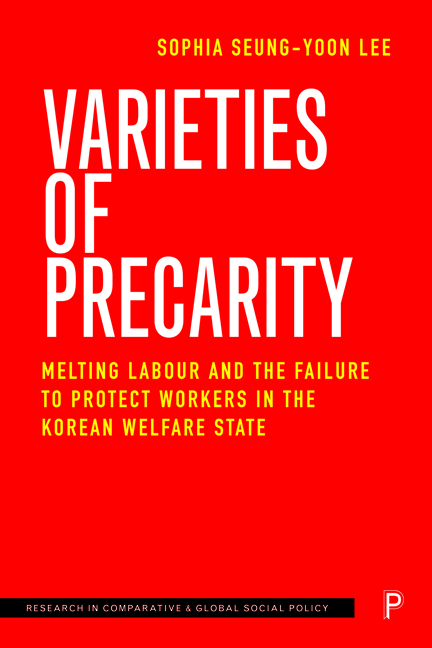 Varieties of Precarity
Varieties of Precarity Book contents
- Frontmatter
- Contents
- Series editors’ preface
- List of figures and tables
- Acknowledgements
- 1 Introduction: Melting labour and institutional inconsistency
- 2 Social protection policies and the South Korean labour market in comparative perspective
- 3 When insiders are kicked out: layoffs of regular workers in manufacturing
- 4 Same boat, different destiny: subcontracted workers in the Korean shipbuilding industry
- 5 Young and old outsourced female workers in call centres and cleaning services
- 6 Are freelancers really free? The Korean freelance labour market and the precarity of young freelancers
- 7 The digital precariat: various Korean platform workers and the new work logic
- 8 Conclusion: Towards universal institutional protection for precarious workers in the era of melting labour
- Notes
- References
- Index
2 - Social protection policies and the South Korean labour market in comparative perspective
Published online by Cambridge University Press: 03 April 2024
- Frontmatter
- Contents
- Series editors’ preface
- List of figures and tables
- Acknowledgements
- 1 Introduction: Melting labour and institutional inconsistency
- 2 Social protection policies and the South Korean labour market in comparative perspective
- 3 When insiders are kicked out: layoffs of regular workers in manufacturing
- 4 Same boat, different destiny: subcontracted workers in the Korean shipbuilding industry
- 5 Young and old outsourced female workers in call centres and cleaning services
- 6 Are freelancers really free? The Korean freelance labour market and the precarity of young freelancers
- 7 The digital precariat: various Korean platform workers and the new work logic
- 8 Conclusion: Towards universal institutional protection for precarious workers in the era of melting labour
- Notes
- References
- Index
Summary
Flexibility measures and precarious workers in Korea
In this chapter, I will examine the Korean social protection and labour market policies, as well as the empirical trend in the Korean labour market. The chapter will also provide legal and statistical definitions of various new forms of work in Korea, including platform work. Furthermore, I will explore the concept of melting labour by examining the characteristics of non-standard forms of work (NSFW) and their deviation from the traditional standard employment relationship. We will examine how the eligibility criteria for social security are inconsistent with new forms of work, conceptualised as melting labour, and the level of social protection benefits is low due to low wages and contributions. Additionally, employers’ non-compliance with the scheme and their ambiguous employment relationships make it difficult to determine who the employer is.
The Korean labour market underwent significant changes after the economic crisis in 1997. Measures to increase labour market flexibility led to a rise in non-standard employment and dualisation. The International Monetary Fund required restructuring of corporations, improving governance structures, privatising public enterprises and opening capital markets, leading to policies that lowered employment protection and increased the number of layoffs and non-regular workers (Peng I., 2012; Lee S.Y. et al, 2016). With this as the starting point, ‘dismissal for managerial reasons’ became possible through the amendment of the Labour Standards Act in 1996, and regulations and a flexible working hours system for parttime workers were added. The Act on the Protection of Temporary Agency Workers was introduced in 1998 to justify massive layoffs and increases in irregular employment (Lee S.Y. et al, 2019b). Moreover, many labour market flexibility policies were introduced with the passing of the Act on the Protection, etc. of Dispatched Workers in 1998, along with other measures. The purpose of introducing the policy was to enable the flexible operation of employment relations, provide a flexible working hours system and ensure the proper operation of workers’ dispatch business, among other measures.
However, the introduction of the policies lowered the level of employment protection, allowing for an increased number of layoffs and creating more significant numbers of non-regular workers. Notably, since then, the number of non-standard workers rapidly increased as many companies have started replacing regular with non-regular workers with short-term/fixed-term contracts (see Figure 1.3 for international comparison).
- Type
- Chapter
- Information
- Varieties of PrecarityMelting Labour and the Failure to Protect Workers in the Korean Welfare State, pp. 34 - 56Publisher: Bristol University PressPrint publication year: 2023
